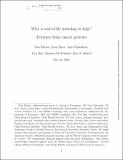Why Is End-of-Life Spending So High? Evidence from Cancer Patients
Author(s)
Zeltzer, Dan; Einav, Liran; Finkelstein, Amy; Shir, Tzvi; Stemmer, Salomon M; Balicer, Ran D; ... Show more Show less
DownloadPublished version (517.6Kb)
Publisher with Creative Commons License
Publisher with Creative Commons License
Creative Commons Attribution
Terms of use
Metadata
Show full item recordAbstract
<jats:title>Abstract</jats:title>
<jats:p>We study the sources of high end-of-life spending for cancer patients. Even among patients with similar initial prognoses, spending in the year post diagnosis is over twice as high for those who die within the year than those who survive. Elevated spending on decedents is predominantly driven by higher inpatient spending, particularly low-intensity admissions. However, most such admissions do not result in death, making it difficult to target spending reductions. Furthermore, end-of-life spending is substantially more elevated for younger patients, compared to older patients with similar prognosis. Results highlight sources of high end-of-life spending without revealing any natural “remedies.”</jats:p>
Date issued
2021Department
Massachusetts Institute of Technology. Department of EconomicsJournal
The Review of Economics and Statistics
Publisher
MIT Press - Journals
Citation
Zeltzer, Dan, Einav, Liran, Finkelstein, Amy, Shir, Tzvi, Stemmer, Salomon M et al. 2021. "Why Is End-of-Life Spending So High? Evidence from Cancer Patients." The Review of Economics and Statistics.
Version: Final published version